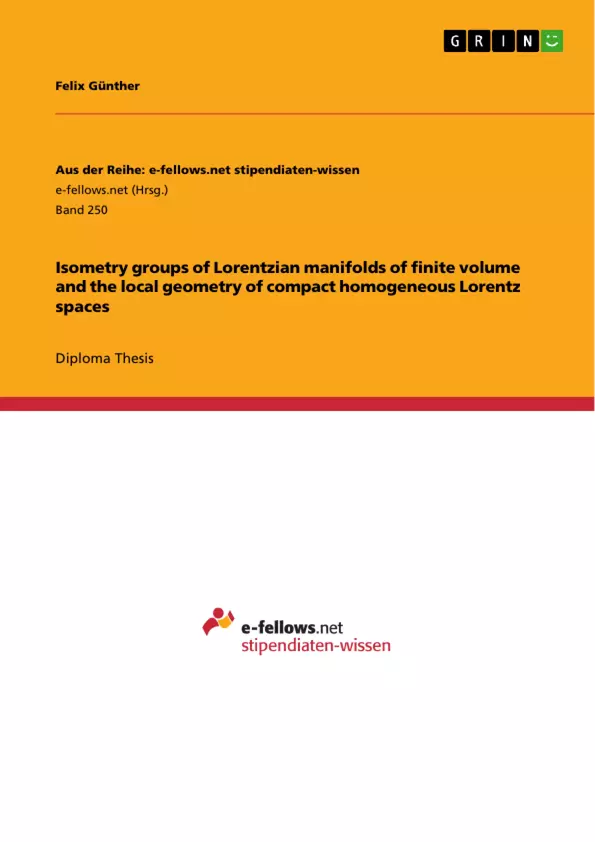Based on the work of Adams and Stuck as well as on the work of Zeghib, we classify the Lie groups which can act isometrically and locally effectively on Lorentzian manifolds of finite volume. In the case that the corresponding Lie algebra contains a direct summand isomorphic to the two-dimensional special linear algebra or to a twisted Heisenbergalgebra, we also describe the geometric structure of the manifolds if they are compact.
Using these results, we investigate the local geometry of compact homogeneous Lorentz spaces whose isometry groups have non-compact connected components. It turns out that they all are reductive. We investigate the isotropy representation, curvatures and holonomy. Especially, we obtain that any Ricci-flat compact homogeneous Lorentz space is flat or has compact isometry group.
Inhaltsverzeichnis (Table of Contents)
- Introduction
- Lie groups acting isometrically on Lorentzian manifolds
- Definitions and basic properties
- Examples
- Product with a compact Riemannian manifold
- Two-dimensional affine algebra
- Special linear algebra
- Heisenberg algebra
- Twisted Heisenberg algebras
- Induced bilinear form on the Lie algebra
- Main theorems
- Algebraic theorems
- Geometric theorems
- Theorems in the homogeneous case
- Algebraic classification of the Lie algebras
- Symmetric bilinear forms on Lie algebras
- Nilradical
- Radical
- Compact radical: case of the special linear algebra
- Non-compact radical
- Form not positive semidefinite: case of the twisted Heisenberg algebra
- Form positive semidefinite
- General subgroups of the isometry group
- Trivial case
- Case of the affine algebra
- Case of the Heisenberg algebra
- Case of the twisted Heisenberg algebra
- Case of the special linear algebra
- Geometric characterization of the manifolds
- Induced bilinear form is positive semidefinite
- Locally free action
- Induced bilinear form is indefinite
- Lorentzian character of orbits
- Orthogonal distribution
- Structure of the manifold
- Lorentzian metrics on the twisted Heisenberg group
- Compact homogeneous Lorentzian manifolds
- Structure of homogeneous manifolds
- General reductive representation
- Geometry of homogeneous manifolds
- Curvature and holonomy of homogeneous semi-Riemannian manifolds
- Isometry group contains a cover of the projective special linear group
- Isometry group contains a twisted Heisenberg group
- Isotropy representation and Ricci-flat manifolds
- A Complete Jordan decomposition
- References
- Declaration of authorship
Zielsetzung und Themenschwerpunkte (Objectives and Key Themes)
This thesis aims to classify Lie groups acting isometrically and locally effectively on Lorentzian manifolds of finite volume. The thesis also investigates in detail compact homogeneous Lorentzian manifolds whose isometry groups have non-compact connected components.- The role of symmetries in geometry and other disciplines
- The study of isometry groups in semi-Riemannian geometry
- The structure and action of isometry groups on manifolds
- The distinction between the Riemannian and Lorentzian cases regarding isometry groups
- The classification of Lie groups acting on Lorentzian manifolds
Zusammenfassung der Kapitel (Chapter Summaries)
The first chapter introduces the basic concepts and definitions related to Lie groups acting isometrically on Lorentzian manifolds. It includes examples such as the product with a compact Riemannian manifold, the two-dimensional affine algebra, the special linear algebra, the Heisenberg algebra, and twisted Heisenberg algebras. The chapter also discusses the induced bilinear form on the Lie algebra.
The second chapter presents the main theorems of the thesis, divided into algebraic, geometric, and homogeneous cases. These theorems provide a foundation for the subsequent classification and analysis of the Lie groups and manifolds.
The third chapter focuses on the algebraic classification of the Lie algebras, analyzing symmetric bilinear forms, nilradical, radical, compact radical (specifically the special linear algebra case), and non-compact radical. The non-compact radical section further explores cases where the form is not positive semidefinite (twisted Heisenberg algebra) and when it is positive semidefinite. The chapter concludes by examining general subgroups of the isometry group in different cases.
The fourth chapter delves into the geometric characterization of the manifolds, exploring cases where the induced bilinear form is positive semidefinite, where the action is locally free, and where the form is indefinite. The indefinite case is further investigated in terms of Lorentzian character of orbits, orthogonal distribution, structure of the manifold, and Lorentzian metrics on the twisted Heisenberg group.
The fifth chapter focuses on compact homogeneous Lorentzian manifolds, analyzing their structure, general reductive representation, and geometry. The geometry section explores curvature and holonomy, cases where the isometry group contains a cover of the projective special linear group, cases where the isometry group contains a twisted Heisenberg group, and the relationship between the isotropy representation and Ricci-flat manifolds.
Schlüsselwörter (Keywords)
This thesis focuses on the study of isometry groups acting on Lorentzian manifolds of finite volume, particularly compact homogeneous Lorentzian manifolds. Key themes include the classification of Lie groups, the geometry of homogeneous manifolds, and the relationship between the isometry group and the structure of the manifold. Important concepts include the induced bilinear form on the Lie algebra, the nilradical, the radical, and the isotropy representation.- Quote paper
- Felix Günther (Author), 2011, Isometry groups of Lorentzian manifolds of finite volume and the local geometry of compact homogeneous Lorentz spaces, Munich, GRIN Verlag, https://www.grin.com/document/179225



